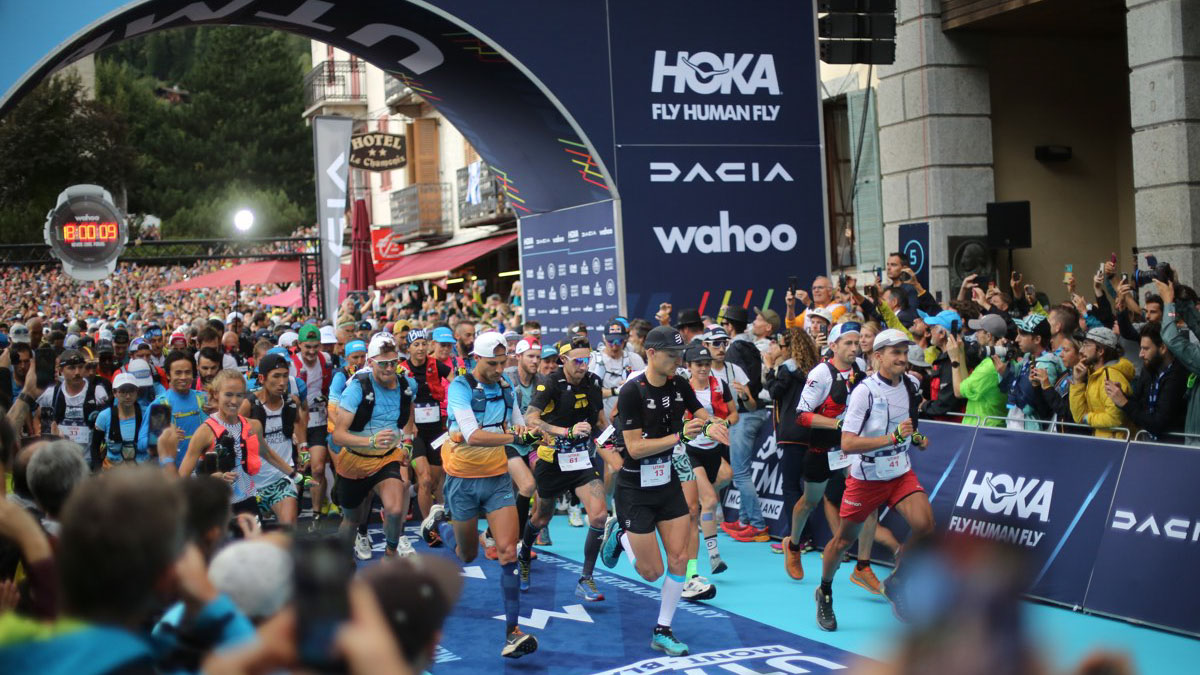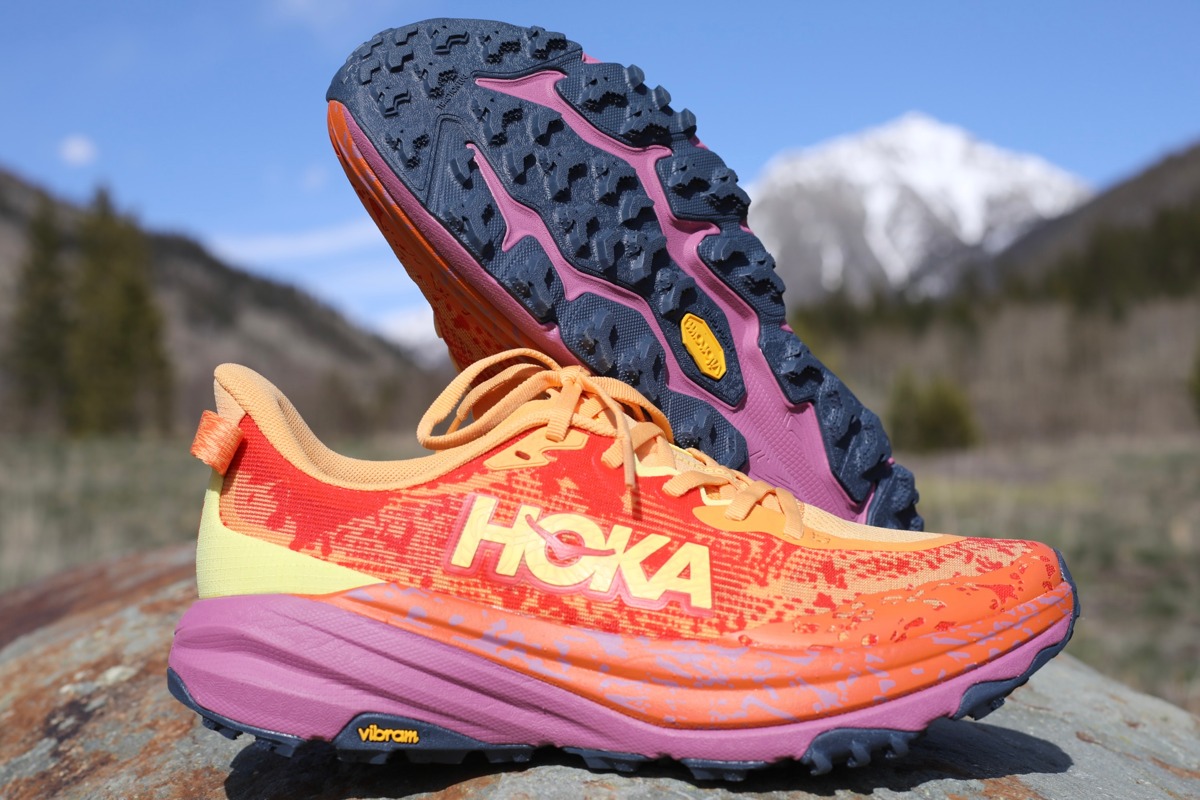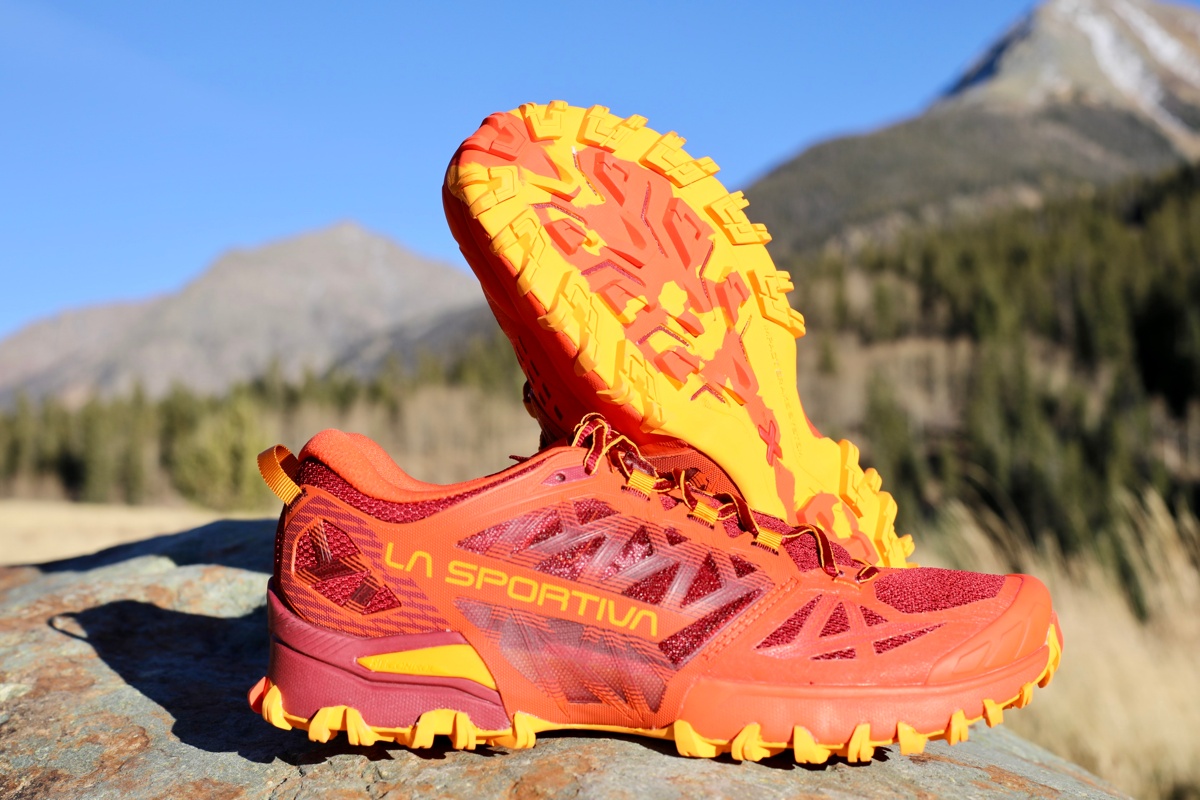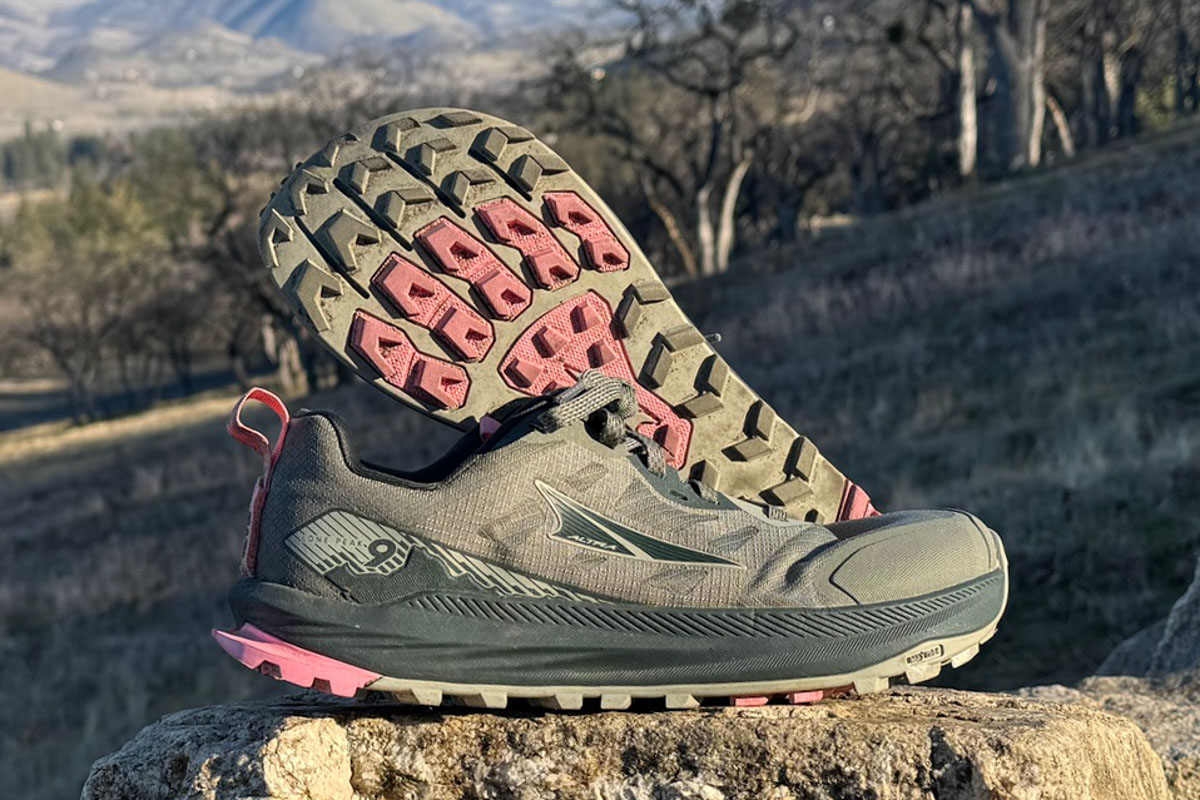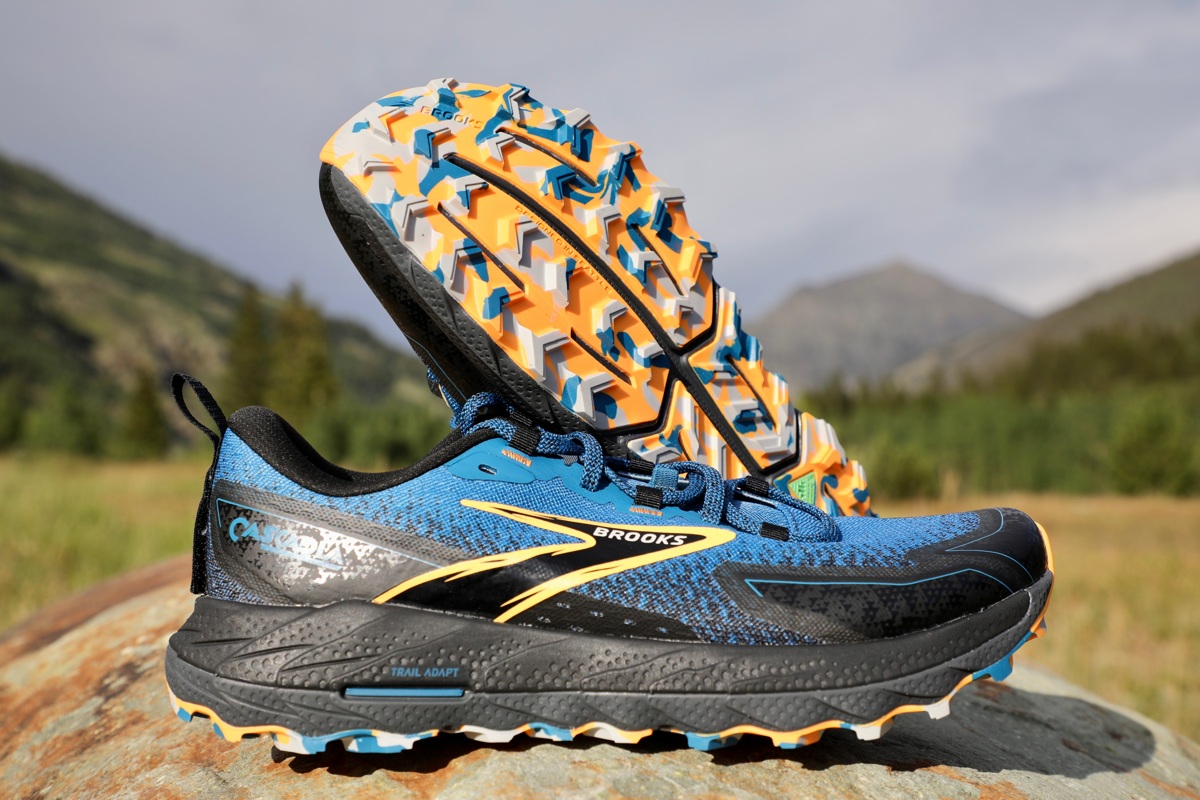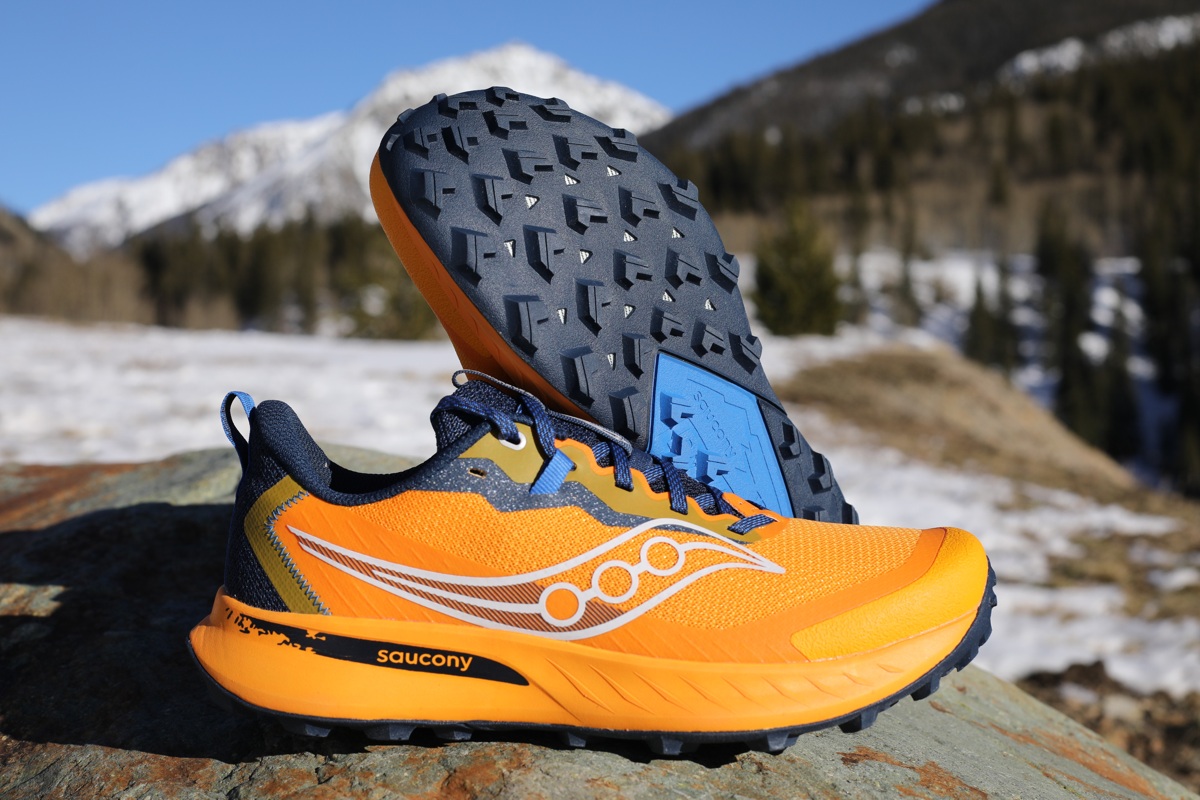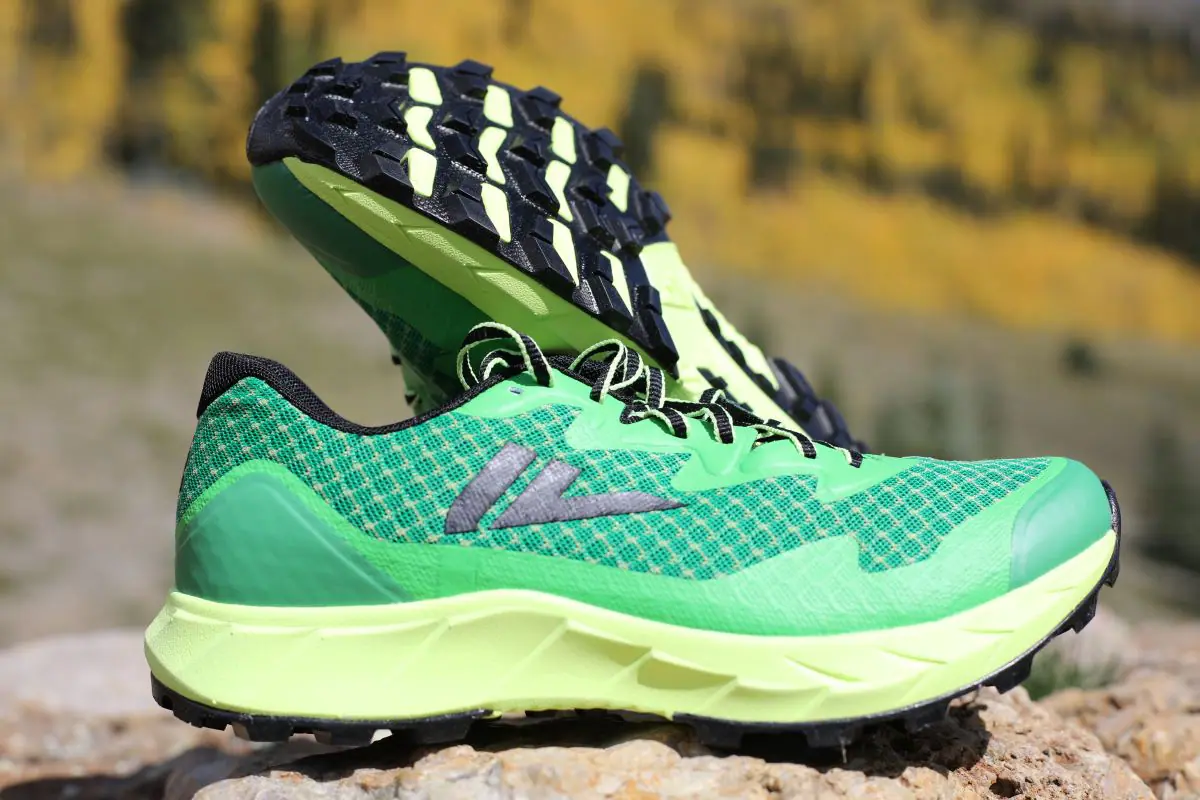Wow! How far trail running shoes have come over the past few decades. From likely no more than one or two models in any geographic market in the early 1990s to a handful of options that all too often resembled hiking shoes in the early 2000s, now, more than 30 brands are offering far more than 200 trail running shoe models at any given time. Indeed, it’s a marvelous time to be a trail runner.
However, all those choices can be overwhelming, even paralyzing. With that in mind, we put our decades of experience with trail shoes and trail running brands to work in trying to simplify the trail running shoe landscape into something more manageable. Below, we list nine trail running shoe brands you can’t go wrong with, what makes each brand stand out, and what some of their key models are. For more detailed looks, see our trail running shoe reviews.
You can also head over to our best trail running shoes guide for a can’t-miss list of top trail shoes. If you’re looking for a specific type of trail running shoes, you can check out our best cushioned trail running shoes, best trail running shoes for mud, and best lightweight trail running shoes guides.
Hoka
Location: Goleta, California
Popular Models: Speedgoat, Torrent, Stinson, Tecton X
What We Like: Quite possibly the plushest trail shoes on the market
What We Don’t: The higher stack heights of the most cushioned models can feel unstable on rough terrain
Born in the Alps, the Hoka form was originally a removable “overshoe” meant for bombing down thousands of vertical meters in one go without beating up your body. Well, that concept evolved into the highly cushioned, rockered shoe design that’s made Hoka famous for over a decade.
While not the brand’s first trail model, the Hoka Speedgoat is most exemplary of the brand’s current trail shoe offerings, with a thick, highly cushioned midsole built with a highly rockered design atop more than adequate lugging and an upper that locks your foot into place.
If you want to take max cushioning to the extreme, then the Stinson is for you. Plush doesn’t do the Stinson justice, and the brand’s description of the shoe as a hovercraft might just work. Yeah, there are four-millimeter lugs, a breathable upper, and a gusseted tongue, but you buy this shoe for a heaping dose of its midsole cush. Of course, not everyone wants a super cushioned ride, and that’s where a shoe like Hoka’s Torrent comes into play with more moderate cushioning in what’s still a distinctly Hoka and trail-worthy shoe.
With super shoes all the rage on the roads, Hoka was one of the first to offer a similar experience on the trails with its Tecton X line, which features plenty of cushion, rocker, and a carbon plate in a trail-worthy offering.
For more on what’s going on at Hoka, check out our full reviews of the Hoka Mafate Speed 4, Hoka Speedgoat 6, Hoka Torrent 4, and Hoka Zinal 2.

The Hoka Tecton X 3 is just one of the brand’s ultra-cushioned trail shoes. Photo: iRunFar/Eszter Horanyi
Nike
Location: Beaverton, Oregon
Popular Models: Pegasus Trail, Wildhorse, Kiger
What We Like: Nike isn’t just adding lugs to road shoes and calling them trail shoes
What We Don’t: Trail running seems like an afterthought for a brand that could bring more variety and innovation to the sport
In late 2013, global sports behemoth Nike reentered the trail running world with meaningful offerings of the Kiger and Wildhorse models, which are both quickly approaching their tenth iterations. The Kiger has always had a lower drop and been aimed at speedier running, while the Wildhorse has been the more generalist trail runner of the two models, with a higher drop and a more cushioned feel. The Pegasus Trail gives runners a great road-to-trail feel with the most generous heel-to-toe drop of all of Nike’s trail models and has become one of, if not the best all-around trail running option out there.
As you’d expect from a leader in the overall running space, all of Nike’s trail shoes provide superior fit and finish. They’ve got great midsole and outsole materials, incredibly comfortable uppers, and top-of-the-line construction. While not breaking the mold, Nike’s trail models also tend to include small elements that may or may not catch on across the industry with time.
For more on what’s going on at Nike, check out our full reviews of the Nike Pegasus Trail 5, Nike Kiger 9, Nike Ultrafly, and Nike Zegama 2.
Salomon
Location: Annecy, France
Popular Models: Speedcross, S/Lab Ultra
What We Like: High-quality construction with a huge variety of models to hit nearly everyone’s needs
What We Don’t: Almost too many models to choose from
In the late 2000s, Salomon was already the dominant trail shoe brand in Europe but very much a secondary offering in the U.S., outside of its top-of-the-charts trail-shoes-for-hiking models. Now, it’s no longer uncommon to see Salomon shoes on American trails. The brand has enough of the market to offer a dizzying array of models that fit nearly everyone’s needs, from the shortest and fastest trail racers to shoes that can easily tackle your next 200-mile race.
It’d be a fool’s errand to try and spell out even a majority of Salomon’s offerings, but here are a few highlights to give you a feel. To start, there’s the Speedcross, which, while not at all flashy, has been the hallmark of the brand’s trail running offerings for a decade and a half with the line’s luggy outsoles, well-structured uppers, and Speedlace lacing system. The fact that Salomon is only on version six with the Speedcross after so many years is a testament to just how well the shoe works.
The S/Lab Ultra line has simplified over the years, leading to a great shoe for that five-mile trail run out your backdoor or your next multiday effort in the mountains. Salomon continues offering an option for the fastest trail running with the ultralight, highly rockered S/Lab Pulsar, stirring things up at the racing end of the spectrum.
If there’s been one general issue with Salomon, it’s that some folks find their shoes run a bit long and narrow.
For more on what’s going on at Salomon, check out our full reviews of the Salomon Genesis, Salomon Glide Max TR, Salomon S/Lab Pulsar 3, Salomon S/Lab Ultra 3 v2, Salomon Sense Ride 5, and Salomon Speedcross 6.

Salomon athlete Courtney Dauwalter sets a new course record at the 2023 Western States 100. Photo: iRunFar/Meghan Hicks
La Sportiva
Location: Italian Dolomites
Popular Models: Bushido, Jackal, Akasha
What We Like: Great sticky rubber and some precise fits
What We Don’t: The smaller, lower-volume fit of many models can make choosing a size challenging
For what feels like a niche brand, it’s amazing that La Sportiva offers standout products for several outdoor pursuits. What unites these pursuits are mountains, with climbing shoes, alpinism boots, and top-notch ski mountaineering equipment, along with some great trail running shoes. Not surprisingly, given the brand’s climbing heritage, La Sportiva offers many trail shoes with a precise fit and excellent rubber compounds for its shoe outsoles.
If you want to try a pair of La Sportiva trail shoes, the Bushido, with its moderate weight, cushion, and heel-to-toe drop, is a great place to start. The Jackal would be a great option for ultra-distance trail runs, given its generous fit and cushioning. Another well-loved, ultra-worthy model is the Akasha, which our testers glowingly describe as a lace-up slipper.
For more on what’s going on at La Sportiva, check out our full reviews of the La Sportiva Akasha II, La Sportiva Jackal II, La Sportiva Jackal II BOA, La Sportiva Prodigio, and La Sportiva Levante.
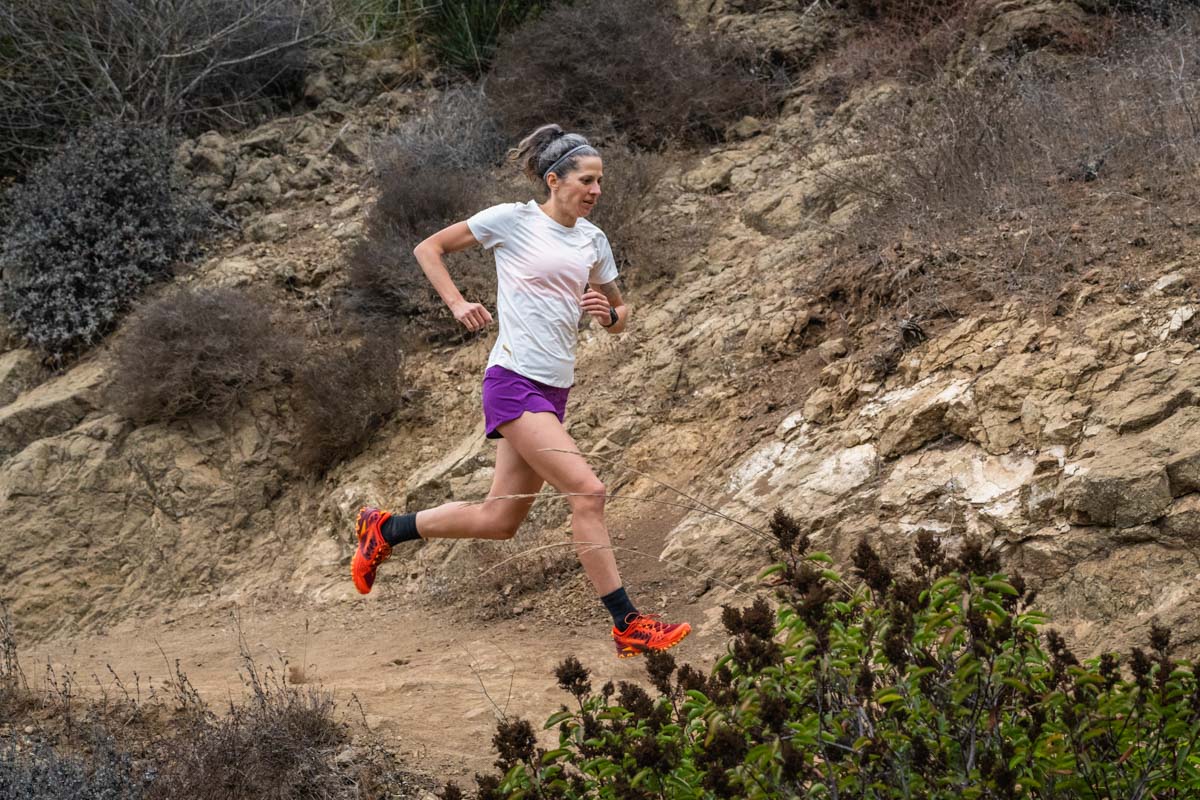
The La Sportiva Bushido II is a great middle-of-the-road trail shoe option. Photo: iRunFar/Eszter Horanyi
Altra
Location: Denver, Colorado
Popular Trail Models: Lone Peak, Olympus, Superior, Timp
What We Like: Roomy toeboxes and a variety of zero-to-low-drop options
What We Don’t: Switching to zero- or low-drop shoes can be a challenging transition
Nike has its waffle iron origin story, while Altra has its toaster oven story in which its founders, while working at a running shop near Utah’s Wasatch Mountains, would remove running shoe outsoles, shave off the heel to remove all heel-to-toe drop, and then reattach the outsole in a toaster oven. While the brand officially launched with a road model, it made its name with the original Lone Peak trail shoe, named after a peak in the Wasatch Mountains.
While the shoe’s materials and construction have improved since the first model launched a decade ago, someone who hasn’t seen the Lone Peak since then would still recognize the Lone Peak 9, nearly 10 iterations later.
Indeed, Altra has stayed core to its roots, never deviating from its commitment to shoes with no or low drop from heel to toe and roomy, foot-shaped toeboxes across its line. The most significant change in the company’s history occurred with the launch of multiple 4-millimeter drop models in 2024.
A favorite of trail runners and thru-hikers alike, the Lone Peak remains Altra’s flagship trail model. It offers a moderate amount of cushioning that’s enough for most people to tackle their daily run or a 100-miler in burly mountains. The shoe also retains the moderate lugging, heel rudder, and gaiter attachments that have long been hallmarks of the Lone Peak.
Altra offers its Timp model for those looking for just a bit more cushion than the Lone Peak. The Timp offers a similar outsole to the Lone Peak except for removing the rudder. For those looking for the plushest of trail rides, there’s the Olympus, which offers maximal cushioning.
The Olympus also has the most robust upper for a bit more structural stability than other Altra trail shoes. On the other side of the spectrum is the Altra Superior, the lightest and lowest stack height of the Altra trail shoes.
Note that folks new to Altra or any low-drop shoes will want to gradually increase their miles in these shoes or risk significant calf tightness and Achilles pain.
For more on what’s going on at Altra, check out our full reviews of the Altra Lone Peak 9, Altra Mont Blanc BOA, Altra Olympus 6, and Altra Experience Wild.
Brooks
Location: Seattle, Washington
Popular Models: Cascadia, Catamount, Divide
What We Like: The brand offers both legacy and cutting-edge trail models
What We Don’t: The legacy models haven’t yet incorporated the materials and manufacturing of the 2020s
It’d be wrong to begin a discussion of Brooks trail shoes with anything other than the Cascadia, of which there’ve been more generations (18 as of early 2025) than any other trail shoe we know of. Indeed, if there were a trail running shoe hall of fame, the Cascadia would be a first-ballot inductee. The Cascadia was born out of a collaboration with ultrarunner Scott Jurek when he was in the midst of winning seven straight Western States 100s.
The model has always featured a moderately lugged outsole, a middle-of-the-road midsole, and a simple upper that’s generally only been tweaked from generation to generation. Even with a significant overhaul with the Cascadia 16, the shoe remains distinctly the Cascadia.
While there’s merit in the Cascadia retaining its characteristic form for so long, if you’d asked me a decade ago what it might look like today, I’d say it might have looked an awful lot like the Brooks Catamount. The Catamount runs a couple of ounces lighter and is more breathable than the Cascadia without sacrificing cushioning or comfort. In my mind, it’s what the Cascadia was, but with a decade of manufacturing and materials advancement baked in.
In all honesty, the Catamount feels like a winner. The Divide line might be right for those just getting into trail running from the roads or those looking for a simpler or more affordable model that transitions well from road to trail. Indeed, it’s my first choice among Brooks’s trail offerings.
For more on what’s going on at Brooks, check out our full reviews of the Brooks Caldera 7, Brooks Cascadia 18, Brooks Divide 5, and Brooks Catamount 3.

The Brooks Cascadia 18 is the latest in the longest-running line of trail shoes on the market. Photo: iRunFar/Eszter Horanyi
Inov8
Location: Lake District, England
Popular Models: Inov8 is revamping its entire trail running line, so we’re waiting to see what new favorite offering arise
What We Like: Grip, grip, and more grip
What We Don’t: For all their models and years, there’s yet to be that one model that’s the clear knock-out, everyday workhorse from the brand
Born in England’s Lake District, the heart of the country’s fell-racing scene and a place with more than its fair share of rain, Inov8’s veritable tree of shoes springs forth from grippy roots. Indeed, we suspect most Inov8 diehards started down that path looking for something grippier than most trail shoes.
Traditionally, Inov8 built that grip for climbing and descending steep, trail-less hillsides with deep, toothy lugs held firmly to the foot with tighter-fitting, well-structured uppers. A few years back, Inov8 added graphene to the outsole compound of some shoes to form its G-Grip models and provide even more traction.
Inov8 offers a dizzying array of models for a small, independent brand. While the brand still offers shoes with world-leading traction in foot-hugging packages, it now offers shoes with all levels of traction to appropriately tackle any sort of terrain. This includes a much wider array of fits, from narrow racing lasts to moderate everyday shoe fits to more accommodating uppers for ultramarathon-length outings. Indeed, it’s even begun offering multiple fits of particular models.
Be aware that some of Inov8’s most attention-catching models might pair low to no heel-to-toe drop and a minimal underfoot package that runners should ease into. These models are likely not suited to everyday running in most cases. That said, Inov8 offers plenty of models that most runners could step into and find comfort and success in from day one.
While most shoe brands state a shoe’s weight based on a U.S. men’s 9, 9.5, or 10, Inov8 states its weight in grams as an average across the model’s entire gender and size run. Thus, its shoe weights, referenced by the number in a model’s name for older models (and still referenced in brand-provided weights), appear lower than what they’d be if stated per the industry standard.
To learn more about shoes from Inov8, check out our full reviews of the Inov8 Mudtalon Speed, Invo8 Trailfly, and Invo8 Trailfly Speed.
Topo
Location: Greater Boston, Massachusetts
Popular Models: Ultraventure, Terraventure, MTN Racer
What We Like: Trail shoes with wide toeboxes available over a variety of lower heel-to-toe drops
What We Don’t: No offerings pushing the bounds of what’s possible
In polling our readers and writers about favorite trail shoe models, Topo is a brand that got a lot of mentions across a wide variety of models. That suggests that the brand has hit the mark with its formula of simple shoes with generous toeboxes and low heel-to-toe drop while offering a quiver of shoes that meets a variety of trail runners where they’re most comfortable — and with plenty of comfort.
To start things at Topo’s most comfortable, there’s the Ultraventure with plenty of cushion, some light guidance built into the upper rim of the midsole, and five millimeters of heel-to-toe drop.
The Terravanture line offers a more moderate amount of cushioning and a more rugged upper on a shoe with three millimeters of drop. The MTN Racer has five millimeters of drop while being firmer and more responsive underfoot with a bit of stability built in.
As with Altras, if you’re not used to low-drop shoes, you’ll want to ease into the lower heel-to-toe drop of Topo shoes, particularly shoes with zero millimeters of drop.
For more on what’s going on at Topo, check out our full reviews of the Topo MT-5, Topo Mtn Racer 3, Topo Pursuit 2, Topo Terraventure 4, Topo Traverse, and Topo Ultraventure 4.
Saucony
Location: Greater Boston, Massachusetts
Popular Model: Peregrine
What We Like: The Peregrine being a workhorse for over a decade
What We Don’t: We’d love an even more stripped-down version of the Peregrine
Saucony is another well-established running shoe company that has successfully entered the trail running world. The brand laid that foundation of success over a decade ago when it ported its very popular road-racing shoe, the Kinvara, to the trails in the form of the Peregrine.
Over the past decade, the Peregrine has taken on a life of its own, with its franchise model eventually evolving from a heavily lugged trail racing shoe to a more moderately lugged everyday trail running shoe.
For more of what’s happening at Saucony, check out our full Saucony Peregrine 15 review.

The Saucony Peregrine is the brand’s leading trail shoe and is available in three different models. Photo: iRunFar/Eszter Horanyi
Where to Buy Trail Running Shoes
If you’re in the market for some trail shoes and you have the chance, swing by your local running store to get set up with a pair. Not only will they have the knowledge to match a pair to your needs and properly size the shoes, but the store’s selection should also be well-suited for local trails. Many local outdoor stores also carry a selection of trail running shoes (as they often double as great hiking shoes) that would once again be suited for the local environment.
If you know what you’re looking for, online outdoor retailers like REI and Backcountry carry a massive selection of trail shoes from a multitude of manufacturers. These days, you’re likely to find just as many or more trail shoes on Amazon, with free two-day shipping if you’re a Prime member. If you’ve still not found a trail shoe that strikes your fancy, you could keep poking around Road Runner Sports, Fleet Feet, Running Warehouse, and even smaller specialty sites like Skyrun until you find your match.
Other Trail Running Shoe Brands
There are many other trail running shoe brands out there. We’re truly in a golden age of quality and variety in trail running shoes. Below, we share other quality brands in the trail running shoe world at the moment. To break up what would otherwise be far too long of a list, we’re dividing these by brands based in North America and ones based overseas.
North America-Based Brands
- Arc’teryx – Arc’teryx, a sister brand of Salomon, makes some luxurious trail shoes — with prices to match. The fit and finish are top-notch, with the ultra-comfy, all-day feel of trail shoes like the Norvan LD and LD GTX models.
- Atreyu – The former subscription-only shoe company now offers The Base Trail.
- Merrell – Merrell made its biggest splash in the trail running world with its decade-old Trail Glove line of minimalist, no-drop, barefoot-style trail running shoes. However, the brand offers plenty of well-made, affordable shoes for everyday trail running, like the Antora for women and Nova for men, while pushing boundaries with racing shoes in the Long Sky and Skyfire lines. To learn more, read our reviews of the Merrell MTL Long Sky 2 Matryx, Merrell Antora 3, Merrell Morphlite, and Merrell MTL Skyfire 2.
- Montrail – Columbia bought Montrail in 2006 and continued to operate it as an independent brand until it converted to the Columbia Montrail sub-brand in 2017. In the early 2020s, Columbia killed the sub-brand concept with Montrail, again, the primary mark. While it only offers one model as of early 2024, there are plans for an expanded lineup. Read more at our Montrail Trinity AG II review.
- Naked – Famous for its packs and running belts, Naked now makes the Naked T/r trail racing shoe.
- New Balance – Long a leading brand in the trail running world, New Balance has reduced its lineup to two bona fide trail shoes in the U.S. market, the More Trail and Hierro, which are heavily cushioned models. For more, read our New Balance Fresh Foam X Hierro v8 review.
- Norda – A high-end shoe brand from Quebec, Canada, that offers two versions of its 001, one with carbide spikes and one without, as well as the 002 and slip-on 003. Learn more in our Norda 001 review.
- Skechers – Their models frequently change. As of our latest update, they offer the highly cushioned GOrun Supersonic Max A/T.
- Speedland – The first mover in the very high-end trail shoe world with its SL and GS models, which see frequent, slightly varied limited releases. As of this writing, they offer two quite different versions on their GL trail platform.
- The North Face – The North Face relaunched its trail running shoes entirely on its Vectiv platform, ranging from its carbon-plated pinnacle product, the Vectiv Pro, to the plateless, lighter, and more reasonably priced Vectiv Enduris. For more, read our reviews of the TNF Altamesa 300, TNF Altamesa 500, and TNF Summit Vectiv Sky.
- Vimazi – A new shoe brand with “pace tuned” shoes run by a former shoe exec at Montrail, SCOTT, and Pearl Izumi that launched two trail models in the summer of 2023. Check out our Vimazi Trail Z2 review for more.

The Merrell Agility Peak 5 is just one of many affordable trail options from the brand. Photo: iRunFar/Eszter Horanyi
Overseas Brands
- adidas Terrex – While sharing a name, adidas Terrex is a distinct entity from adidas, which has also offered trail shoe models. The Agravic Speed and Agravic Speed Ultra models currently headline adidas Terrex’s offerings.
- ASICS – ASICS is only intermittently active in U.S. trail running but is a stronger player in Europe and Japan. Currently, ASICS offers quite a wide selection of trail shoes in the U.S. market.
- Craft – The Swedish apparel brand jumped hard into trail running shoes in 2021. While Craft’s trail venture started with highly rockered models like the CTM Ultra Trail and CTM Ultra Carbon Trail, the brand now offers more traditional builds like the Pure Trail.
- Dynafit – Dynafit started in the ski world but has made a solid move into the trail running world with strong apparel and shoe lineups. The Ultra 50 is a more than capable long-distance shoe, while the Alpine DNA 2, and Sky DNA lighten things up in two fully capable trail running shoes. For more, check out our Dynafit Sky DNA review.
- Icebug – Another Swedish brand best known for its carbide-tipped shoes for running on ice or off-trail orienteering, Icebug long ago launched numerous non-spiked trail running shoes that perform admirably.
- Kailas – The Chinese outdoor brand Kailas expanded into trail running a few years ago and now offers a dozen models that are available even in the U.S.
- Karhu – Finnish brand Karhu has dipped its toes back into the running market, including one trail offering, the Ikoni Trail.
- Lowa – German bootmaker Lowa began offering trail shoes in 2023.
- NNormal – A collaboration between Kilian Jornet and Camper, NNormal offers four trail running models, the Kjerag racing shoe, the Kboix, and two versions of the more cushioned Tomir.
- On — Swiss running brand On now offers a few trail models, including the Cloudultra, Cloudventure, Cloudventure Peak, and Cloudvista. These shoes feature the brand’s signature CloudTec midsole, which is full of voids. For more, check out our On Cloudultra 2 review.
- Raidlight – French pack and apparel maker Raidlight offers a handful of trail running models.
- SCARPA – Mountain brand SCARPA offers many great trail running offerings, from the light and nimble yet totally capable Spin Infinity to burlier models with tons of protection like the Ribelle Run. For more, read our SCARPA Golden Gate Kima RT, SCARPA Spin Infinity, SCARPA Spin Planet, and SCARPA Spin Ultra reviews.
- Scott – Founded as a ski pole company in Idaho and now perhaps best known as a Swiss bicycle company, the brand has long offered a mix of road and trail shoes, with the trail offerings most commonly standing out for their traction. For more, read our Scott Kinabalu Ultra RC and Scott Ultra Carbon RC reviews.
- VJ Shoes – Finnish brand VJ Shoes now offers six trail running shoes, from its hyper-lugged Spark to its highly cushioned, wider toeboxed Ultra. All have VJ’s ultra-sticky 100% butyl-rubber outsoles. For more, see our reviews of the VJ Lightspeed, VJ MAXx 2, VJ Spark, VJ Ultra 2, and VJ XTRM 2.
- Walsh — Walsh is a classic fell-running brand from the U.K. with super-grippy models, some of which you might find online in the U.S.
Former Trail Running Shoe Brands
Before I wrap up, the history major in me can’t help but name a few more brands that have been part of trail running’s journey.
- adidas – While adidas was one of the first entrants into the trail running shoe world with the Response TR in the early 1990s, non-Terrex adidas trail shoes seem to have completely disappeared from at least the U.S. market.
- Columbia – Columbia has long offered “trail running” shoes, but those models always seemed more aimed at casual wear than frequent trail runs. It appeared that might change in the early 2020s, but that quickly evaporated.
- END – Far ahead of its time, END (Environmental Neutral Design) designed some amazing lightweight, flexible trail shoes with the environment in mind.
- Kalenji – Kalenji was an affordable line of trail running shoes from retailer Decathlon.
- Mammut – Swiss outdoor brand Mammut made several trail running shoes, at least in the mid-2010s, before returning to hiking and casual shoes.
- Oboz – During the trail shoe boom of the early 2010s, upstart outdoor shoe company Oboz joined the mix for a couple of years before concentrating its efforts on hiking and casual shoes.
- Patagonia – In the trail running shoe boom days of the early 2010s, Wolverine manufactured a line of Patagonia shoes.
- Pearl Izumi – For half a decade, Pearl Izumi had a range of trail shoes, including its E:Motion line, a range of easily understood cushioning and stability across both road and trail lines, with gently rockered midsoles and beautifully simple uppers. *sigh*
- Salewa — Salewa offered a category of shoes it called “speed hiking” that were suitable options for trail runners looking for stability or protection.
- Tecnica — This Italian company made at least two attempts to enter the trail running market in the 2010s but doesn’t currently offer any products.
- Teva – If I recall correctly, Teva had a handful of true trail shoes in the late naughts but hasn’t introduced a trail run-specific shoe since the TevaSphere in early 2013.
- Vasque – Over the past two decades, Vasque has had two significant runs in the trail running world, with full lineups from the late naughts into the early 2010s and another line launched in the late 2010s.
Call for Comments
- What’s your favorite trail running shoe brand or brands?
- Do you have any other brands to add to our current or former trail shoe brand lists?
